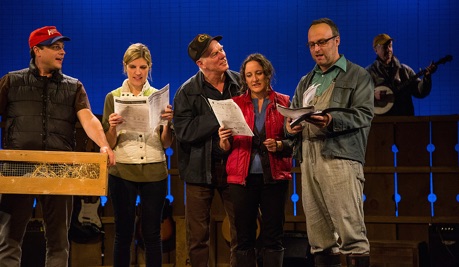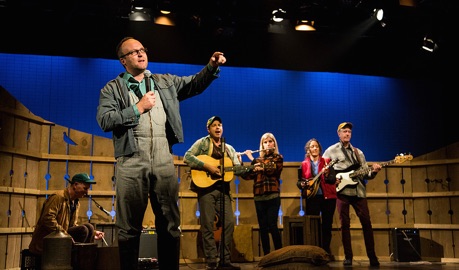Reviews 2017






✭✭✭✭✩
by the company, directed by Severn Thompson
• Blyth Festival, Memorial Hall, Blyth
August 11-September 23, 2017;
June 1-15, 2018;
• National Arts Centre, Ottawa
April 26-May 5, 2019
Arlan: “In every life there is a flood”
The Blyth Festival’s third play of it 2017 season is the world premiere of The Pigeon King, a play collectively written by the company and directed by Severn Thompson, the Festival’s new Associate Artistic Director. Thompson is the daughter of Paul Thompson, famed for the collective creations about local history that he shepherded at Theatre Passe Muraille the most famous of which was The Farm Show of 1972.
In The Pigeon King Severn Thompson continues along the trail her father blazed by allowing a group of actor/musicians to investigate and interview people involved with the rise and fall of Pigeon King International (PKI), a company founded by Arlan Galbraith of Cochrane, Ontario, and to create a play with songs based on their findings. The result is vibrant depiction of one of the greatest, most bizarre frauds in Canadian history featuring a fantastic performance by Gil Garratt as Galbraith.
Galbraith had been a pig farmer along with his brother and parents, but in 1980 their pig farm went bankrupt. The animal Galbraith really loved was pigeons and he had been raising pigeons since he was six and was an active ember of pigeon-racing and pigeon-fancying organizations. As the show portrays it, Galbraith is aware from his own experience of how the owners of family farms often relied on “off-farms jobs” in order to survive. In encouraging farmers to raise pigeons, Galbraith feels he was offering farmers a way to give up their off-farm jobs, spend more time with their families and earn lots of money besides. In 2001 Galbraith founded Pigeon King International to help farmers get into the pigeon-raising business.
Referring to markets for racing pigeons in the Middle East, Galbraith would sell a pair of breeding pigeons to farmers for, say, $250 and then have them sign a contract to sell the young birds produced exclusively back to Galbraith for $25 each for the next ten years. Galbraith had three levels of investing, the higher the price for the pair, the higher the price for the young birds. When Pigeon King International collapsed in 2008, it had almost a thousand breeders under contract in five Canadian provinces and 20 US states. In 2007 hundreds of breeders were making thousands of dollars a year selling pigeons back to Galbraith.

So what could be wrong? The problem is that Galbraith never had any end market. He may have said that he was selling the young birds as racing pigeons to markets in the Middle East, but then he started saying they were being raised for squab. In fact, Galbraith kept the young birds in more than a dozen holding barns to be sold on to new investors. At the time of his trial Galbraith had taken in nearly $42 million from farmers and walked away from obligations to buy back $356 million worth of their young birds, thus driving the then current investors into ruin.
In 2007 a local farm magazine began investigating PKI with the simple goal of determining if it was as good an investment for farmers as Galbraith claimed. It’s investigation found that not only was it not a good investment but that it was illegal. It qualified as a Ponzi (or pyramid) scheme because their was no end market and therefore depended on unsustainable continual expansion for its business.
The Blyth collective has formed this information into a gripping tale that starts out innocently enough but expands in its implications to fantastic proportions. The songs usually derive from words that Galbraith has just said and serve to shift the nature of the story from documentary theatre into the realm of modern parable. Galbraith promises hope to people who need hope and his business depends on trust as do all relationships. How then, we wonder, could so many well-meaning farmers, many of them Mennonites and Amish, have misplaced their trust in a man like Galbraith?
This is where the genius of Garratt’s portrayal comes in. Anyone who saw Garratt last year in The Last Donnelly Standing will find that with the help of costume designer Gemma James Smith he is almost unrecognizable. No longer is Garratt a tough, good-looking young man but a dumpy-looking nerd who speaks with a nasal old-man’s voice that seems to come from the back of his throat. Garratt gives Galbraith severely limited gestural and oratorical variety so that Galbraith in no way comes across as a wily swindler but as an ordinary, slightly dim-witted older man who proposes his scheme to various farmers (played by the company) because he sincerely believes he has come up with a way to help them out of their troubles.
The genius of the collective writing and of Garratt’s portrayal is that Garratt never gives us a clue whether Galbraith is fully aware of what he is doing. The question of whether Galbraith is really a subtle schemer of simply a foolish businessman compels us to listen to every word for the slightest slip-up and to all the evidence to see whether it is simply envious propaganda as Galbraith thinks of it or real criticism that undermines his air of sincerity. Events acted out as witnesses’ flashbacks during the trial scene of Act 2 give us the most potentially damning evidence against him, but the way that Garratt so convincingly plays Galbraith’s protestations of innocence will have you debating long after the final curtain what the true nature of this totally unassuming man really is.
The ensemble, all of whom sing and play their own instruments, is uniformly strong. In terms of the music all the songs and background music, usually in the mode of country western tunes with an excursion into Latin rhythms, captures the ironic, generally reflective mood of the piece. Rebecca Auerbach, Jason Chesworth and J.D. Nicholsen are the principal vocalists and all make powerful contributions.

The ensemble actors also each play multiple, clearly distinguishable roles. Rebecca Auerbach plays the wife of one of the first farmers Galbraith approaches as well as the prosecuting counsel at his trial – doubtful and looking for hope in the first role, confident and uncompromising in the second. J.D. Nicholsen plays Auerbach's farmer husband and an irate loudspeaker-wielding, one-man consumer protection advocate who is the first to call out PKI as a Ponzi scheme. Auerbach and Nicholsen have a devastating scene together as the farm couple who agonize about what to do with all the pigeons they can no longer sell after PKI goes bust.
Jason Chesworth plays a wide variety of roles from farmer to businessman, but his most memorable scene is as one of Galbraith salesmen who is confronted by three pigeon fanciers in a restaurant. As the pigeon-fanciers ask him a a host of innocent questions about breeds and strains, Chesworth shows simply through the change in the salesman’s expression how embarrassment that he knows nothing about what he is selling is followed by anger as he sees through Galbraith’s scheme. His powerful confrontation with an incensed Galbraith is central to our deciding how innocent Galbraith really is.
Birgitte Solem’s principal role is that of the journalist for the small farm journal. We see how she begins her task impartially, simply gathering evidence from varied sources until she sees the direction her information is pointing and her concern and commitment build. George Meanwell probably has his strongest scene when playing a Mennonite farmer who simply and without anger tells Galbraith that he will no longer do business with him.
The set and lighting design by Steve Lucas is very clever. The set gives the general ambiance of an old barn where we can see between the upright slats. Yet, Lucas has carved out pigeons in different forms all over the walls. The back wall is made of wide-gauge mesh on which Garratt as Galbraith hangs cutouts in the shape of pigeons that become silhouettes when Lucas backlights them. The stage is divided in two across its length separating the back from the front acting area by sliding proscenium-height panels of wire mesh that suggest how both the farmers and their birds are trapped in different ways.
The Pigeon King is an excellent example of how good collectively created drama can be. But unlike most group docudramas, what the performances under Severn Thompson’s sure hand insure is that the prime interest in this story is not its certainly but its mystery. For those who think that Ponzi schemes are a fraudulent practice endemic to big cities, The Pigeon King serves as a valuable warning that they can arise right here in rural Ontario. The play also delves into the larger question of the basis of hope and trust and what conditions need to arise for people to deceive others or perhaps deceive themselves. The Pigeon King is a fascinating, highly entertaining play with a universal theme that beyond this initial run deserves a wide audience.
©Christopher Hoile
Note: This review is a Stage Door exclusive.
Photo: (from top) Rebecca Auerbach, J.D. Nicholsen and Gil Garratt; Jason Chesworth, Birgitte Solem, J.D. Nicolsen, Rebecca Auerbach, Gil Garratt and George Meanwell; J.D. Nicolsen, Gil Garratt, Jason Chesworth, Birgitte Solem, Rebecca Auerbach and George Meanwell. ©2017 Terry Manzo.
For tickets, visit www.blythfestival.com.
2017-08-27



The Pigeon King





